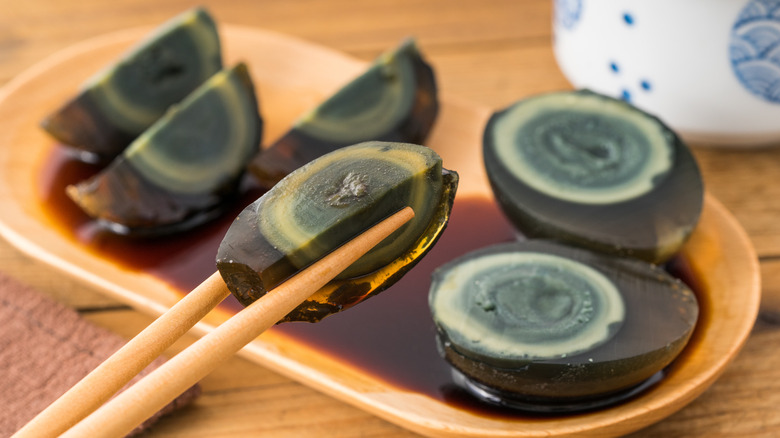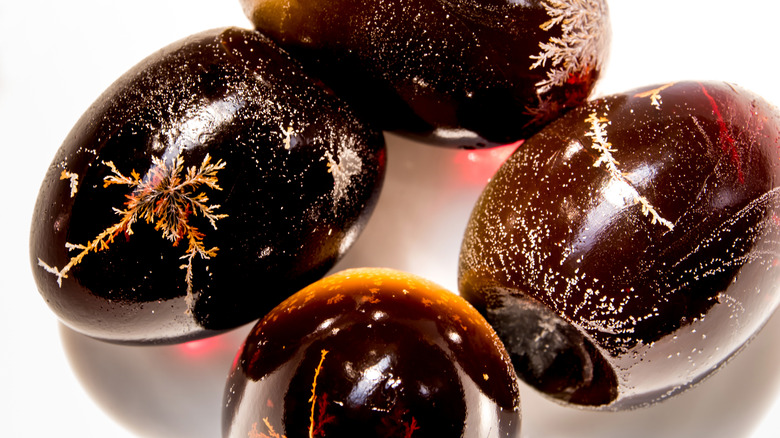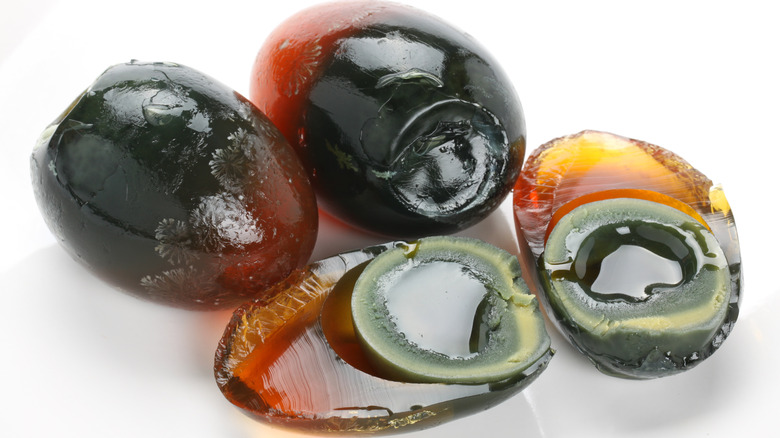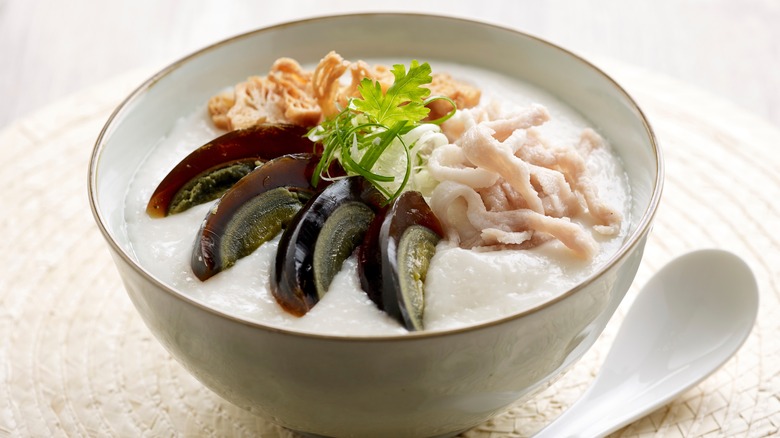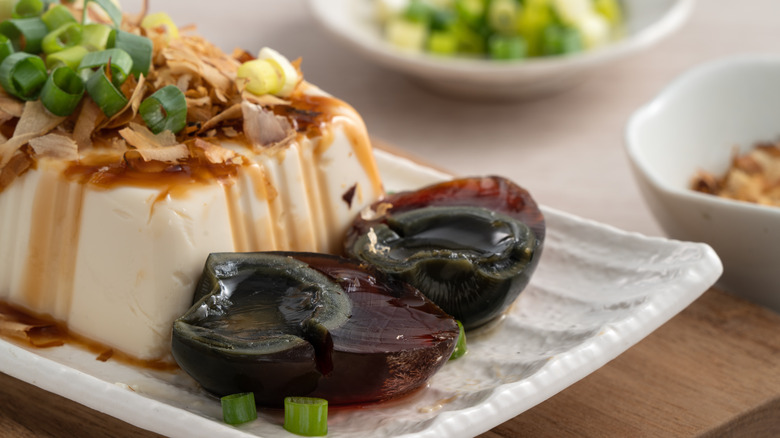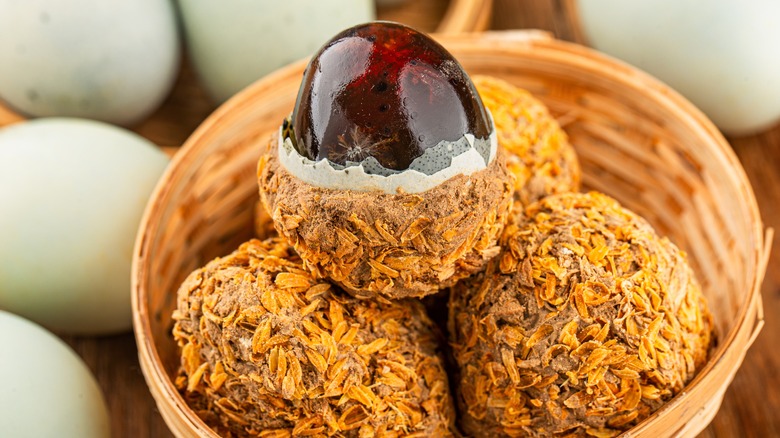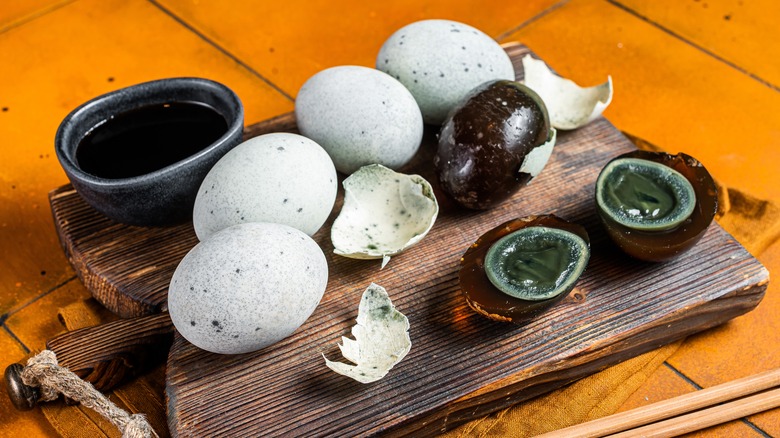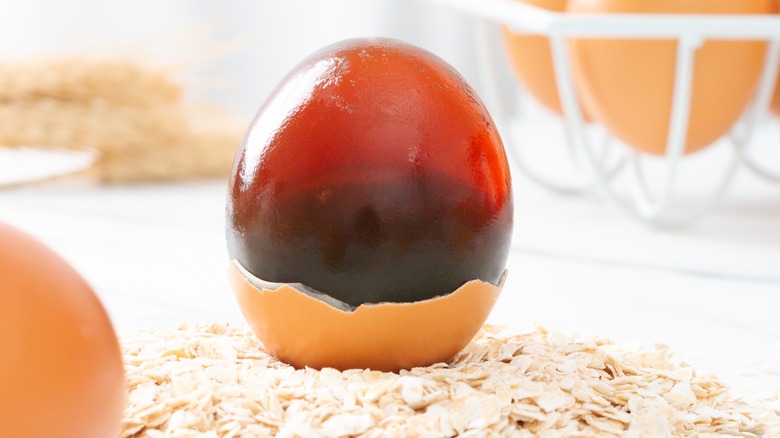What Are Century Eggs And Are They Really 100 Years Old?
Tired of those regular white and yellow eggs that seem like they've been in your fridge for a hundred years? Taste the magic of century eggs, without a time machine — thanks to groundbreaking technological advances in modern science. And also ancient tea.
This Chinese delicacy, traditionally called pídàn in Mandarin, goes by all sorts of names on the internet. But all of them make these things sound really, really old. Century eggs, 100-year eggs, 1,000-year eggs, and millennium eggs are all common monikers for the stiff-smelling, oddly-colored, and pungent-tasting preserved eggs.
Not to burst your bubble, but they're not 100 years old. Not even close. Still, they do give off the sulfuric vibe of possibly having a Jurassic-era bug petrified in the yolk somewhere. (Don't worry, they don't.) How do you eat them, where do you find them, and how the heck do you know if they've gone bad? We've got the rundown on century eggs in five minutes or less. (Grab an egg timer, if you need to.) To the pídàn!
Century eggs are cured with chemicals and tea
Typically, century eggs are made using duck eggs, but they have also featured chicken or even quail eggs. The process starts with a mud-like alkaline mixture of wood ash, salt, clay, and calcium oxide (also known as quicklime) or calcium hydroxide (also called slaked lime). The traditional mix also often happily includes brewed tea, an ingredient we can identify.
The eggs are wrapped in this black mud, coated in rice husk, packed into an air-tight vessel, and left to cure for a few weeks — even up to several months. Commercially produced century eggs can actually be made in as little as two weeks. So, tragically — if you were hoping for it — these preserved eggs are not really 100 years old. Still, the shocking visual transformation definitely makes them look like they're even older than that.
The chemical reaction between sodium carbonate, water, and calcium hydroxide yields sodium hydroxide, which causes the sodium levels of the egg to rise and the egg protein to turn into a jelly-like substance. The egg white also darkens in hue (usually becoming an amber or semi-see-through black), and the yolk gathers greenish, yellow rings that offer a fossil-like aura but still remain soft and creamy, like custard. (Just picturing using these eggs in our favorite egg dishes for a legit jaw-dropping presentation.)
What is the history of the century egg?
More than likely, century eggs were first made around 600 years ago during the Ming Dynasty in China, but there are several possible origin stories. One story says that a man in Hunan, China found eggs that had been laid in the construction waste of his house, and of course, he did what anyone would do and ate them. Another story includes a failed attempt at wooing a lady when a man left eggs outside for her, but they weren't found for several months.
Perhaps the century egg was created accidentally by a restaurant owner in Wujiang County in the Jiangsu province. He poured his spent tea leaves into the ashes of a stove where his ducks would sometimes lay eggs, only to discover the preserved eggs later on. Yet another story says that a farmer just happened upon eggs that had been preserved after sitting in a puddle of muddy water and slaked lime.
Century eggs are completely safe to eat
Century eggs, like many preserved foods, are safe to eat, but it is important to check them for signs of spoilage before eating. While the smell of ammonia will always be present in century eggs, an overwhelmingly bad ammonia odor or moldy stench are signs that things have gone wrong. The shell should be visibly intact with no cracks, holes, or dents. When shaken or tapped, there should be no rattling sound.
It is also important to get century eggs from a reliable source. Where things can get dicey is in the heavy metal department. Some commercial preservation processes have been known to implement lead oxide in order to fast-track the curing process. Lead is toxic to humans and has most often been found in century eggs produced in China. You can enjoy all the tasty benefits of a nutritious century egg — without the lead — by looking for specific labeling designating that the product has not been made using lead oxide. Alternatively, source your century eggs from origins other than China. Lead-free options are often imported from Thailand (known as the pink egg) and other Southeast Asian countries.
What do century eggs taste like and how are they eaten?
The aroma of these preserved eggs is no doubt pungent, smelling intensely eggy and faintly of ammonia. The taste is salty and complex, with a gelatinous white and creamy yolk. While the smell and certainly the sight can be shocking, Carrel Kam, director of the popular Yung Kee Restaurant in Hong Kong, tells BBC, "It's psychological — just like the idea of blue cheese. The smell is terrible, but the taste is good." At Yung Kee Restaurant, century eggs are typically served as an appetizer with pickled ginger. The spicy and sweet ginger acts as a balancing palate cleanser alongside the rich and velvety egg. Century eggs are often served with congee — a simple rice porridge — and century egg congee with lean pork and scallions is a comfort food for many. The eggs can also be served as a simple snack with soy sauce, vinegar, and chiles and pair especially well with an ice cold beer. They are also popularly served alongside silken tofu with a similar sauce.
At dim sum restaurants, you can find glistening puff pastry pockets filled with century egg. A Hunan preparation mashes the century egg with sautéed chiles, garlic, vinegar, soy sauce, and sesame oil and is served with rice. Century egg is even sometimes mixed with ground pork and steamed to make sausages.
While pídàn are certainly something different for the Western palate, these preserved eggs have been enjoyed for centuries and are definitely worth a try.
You can get century eggs just about anywhere
If you're not currently local to Hunan, China where this delicacy can be found just about everywhere from people's homes to grocery stores and bars, you don't need to rush to the hardware store to grab the last bucket of quicklime to make all your century egg dreams come true. (You kept the receipt, right?) All it takes is a trip to your nearest grocery store — or even Amazon.
You won't be digging through a vat of clay to harvest these cured snacks, either. It's more than likely that you'll find them right next to other shelf-stable goods, thoughtfully packaged in sets of four or six, looking like any other commercial brand on the market. They might also be called song hua dan, a designation of a high-quality century egg with visible pine flower patterns (like snowflakes) on the outside from the salt cure. If you find a specialty shop that serves them for immediate consumption, some eggs may even come with a dressing and a pickled ginger garnish. Century eggs are also quite the treat at most dim sum restaurants.
Chinese supermarkets in the U.S. might even sell century eggs still wearing their little woven basket-like jackets (made of wood chips and sand) over their shells. But you'll most often find them in their regular (speckled) eggshells, all standing in a line.
Store century eggs depending on the egg shell
Once you've Amazon Prime'd, fermented, or procured your century eggs from the shelves, how the heck do you store them? Well, if you're not planning on eating them right away, you don't have to do much of anything. Century eggs are well-preserved on their own, and last a very long time compared to their fresh, eggy brethren.
Uncracked, century eggs last for a few months in your cupboard and several months beyond that in your fridge. (Some report they stay fresh indefinitely if refrigerated.) Once you peel back the shell, though, they shouldn't hang around naked in the fridge for more than two or three days.
If you're keeping your eggs in the pantry, be sure to check for any damaged shells in the bunch. Even if an egg just has a tiny crack, it can go rancid as quickly as three days. Of course, like any egg, century eggs effortlessly alert you to their game-over status. There's no mistaking the aroma of a rotten egg in the house.
Century eggs pack a lot of nutrition
Are you wondering just how the intense curing process affects the nutrition of your typical duck egg? As it turns out, century eggs are just as nutritious as fresh duck eggs — except for a couple of noted exceptions.
Century eggs pack just as much protein as a fresh duck egg, at roughly 9 grams per preserved egg compared to the 7 to 9 grams in a fresh duck egg. Fat content is also about the same as a fresh duck egg at around 10 grams, as well as the low carbohydrate value at 1 gram per egg. Where things start to diverge is in the sodium content. While we would expect that an egg preserved in salt would skyrocket into the sodium stratosphere, over 500 miligrams per average century egg doesn't seem too surprising. (A fresh duck egg shows less than half that amount.)

